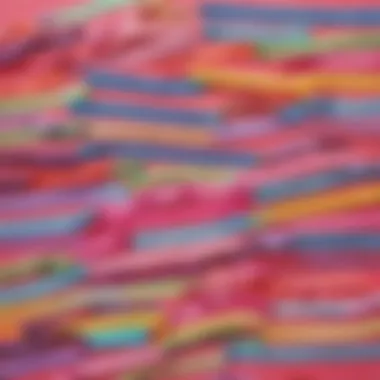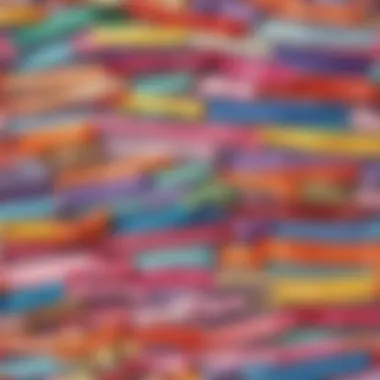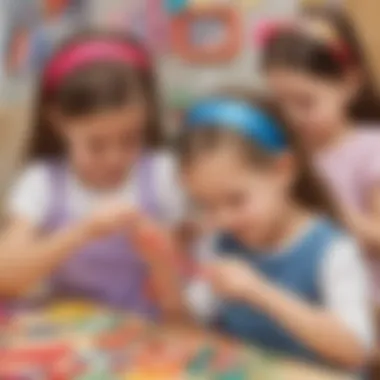Exploring Ribbon Headbands: Creative Craft Ideas for Kids


Intro
Crafting plays an essential role in childhood development. One delightful project is making ribbon headbands. This art form not only keeps children engaged but also enhances their creativity and fine motor skills. In this guide, you will find everything you need to know about creating these beautiful accessories. From a list of materials and step-by-step procedures to design ideas, each part offers a unique perspective into the world of ribbon headbands.
Fun Activities Ideas
Making ribbon headbands is a fantastic way to spark creativity. It can be integrated into various activities that encourage children to express themselves.
Indoor Activities
Indoor crafting provides shelter from weather challenges. Setting up a crafting space for making ribbon headbands enables kids to focus on their artworks. Have all materials handy: ribbons of various colors, glue, scissors, and simple embellishments like beads or sequins. This often turns into an exciting collaborative experience as children share ideas and styles.
Outdoor Adventures
Crafting can spill outside as well. Use garden environments. Picture children fabricating headbands outdoors while being surrounded by nature. Bring materials to the backyard and hold mini-design contests. The natural light also makes colors pop. It adds joy to the crafting experience.
Arts and Crafts
Integrate ribbon headbands into broader arts and crafts activities. For instance, teach kids about color combinations or themes – spring flowers, holiday motifs, destination-themed bands. This creates interest in more intricate designs and weaves education within fun.
Educational Games
Creating ribbon headbands can include educational aspects too. Different games may enhance the crafting experience. For example:
Math and Logic Games
Incorporate math by guiding children to measure ribbons or count beads. Estimating how many materials are needed bridges subject learning to craft completion.
Language and Vocabulary Games
Discussion among children can expand vocabulary. A group can explain their design choices, using descriptive words that foster language skills.
STEM Activities
Engaging young minds in applying STEM principles enrich the craft process. Consider how various materials can impact the durability of headbands. Use trial and error to showcase real-life applications.
Parenting Tips and Resources
Fostering creativity at home remains critical. Setting up a stimulating environment assists this goal. Look to facilitate opportunities, not just in crafting but across playtime.
How to Encourage Creativity
Imitate a supportive space. Offer options without boundaries, inviting kids to explore. Example: present various materials to create one headband, letting kids decide.
Setting up a Playful Learning Environment
Designate a crafting area with tools like scissors, glue, and fabrics completely unlocked. Children ought to enjoy the process without feeling restricted.
Fun Facts and Trivia
Have fun while learning. Children learning about headbands can find amusing information regarding textiles and fashions of different cultures. Historical context adds depth to their crafting adventures.
Engaging in crafts promotes cognitive and dexterous skills. Children can learn problem-solving while exploring artistic expression.
Prelude to Ribbon Headbands
Crafting ribbon headbands offers numerous benefits. This simple project is suitable for children and it is an effective way to develop their motor skills. It can engage the youth in a productive activity and inspire their creativity. Working with colorful ribbons, kids enhance their focus and attention span. Parents and teachers can use this guide to help children in crafting, allowing them to typycally design personalized accessories.
Defining Ribbon Headbands


Ribbon headbands are decorative bands made from various types of ribbons. They can be created in sizes that fit different heads and styles, making them a flexible option for personal expression. In essence, they feature the main material—ribbon—secured typically on an elastic band or a traditional headband base. The standout feature of these headbands is their ease of customize based on color, width, and texture. Overall, they serve as both a fashion statement and a craft project. These headbands are not just fun to wear; they also improve fine motor skills in young children.
The Popularity of Crafting Among Kids
Crafting not only boosts creativity in kids but also encourages collaboration. Children often work together to brainstorm ideas and share materials. This means kids learn social skills while creating something tangible. Studies indicate that engaging in hands-on activities positively affect brain development.
In today's digital era, where screens dominate playtime, crafting offers an important and meaningful alternative. Opting for tangible, handmade projects like ribbon headbands helps maintain children’s connection to physical activity. The appeal of creative projects like this resonates strongly. In sum, crafting remains a popular activity because it genuinely develops essential life skills amongst children.
Materials Needed for Ribbon Headbands
Understanding the materials required for creating ribbon headbands plays a crucial role in the crafting process. This section highlights essential supplies and optional decorations that not only facilitate the making of headbands but also inspire creativity and personalization. Having the right materials can enhance the crafting experience, ensuring that children can develop their artistic skills while engaging in a fun activity.
Essential Supplies
Creating ribbon headbands requires basic but specific materials that ensure a smooth crafting experience. Here are the most important supplies:
- Elastic headband or plain fabric strips: The base of the headband can be standard elastic headbands or strips of fabric that are wide enough to support added decorations.
- Ribbons: Choose different types of ribbon. Grosgrain ribbons, satin ribbons, and organza are popular choices. They come in various colors and patterns that can excite creativity.
- Scissors: A sturdy pair of scissors is essential to cut the ribbons and fabric strips.
- Hot glue gun (or fabric glue): A hot glue gun works best for adhering the ribbons to the headband. It provides a lasting bond. If hot glue is not an option, fabric glue can suffice but may take longer to set.
- Measuring tape or ruler: Accurate measurements ensure the right length of ribbon is cut for the project.
These materials readily available at craft stores provide a solid foundation. It enables kids to get started quickly and allows parents to participate in the project too.
Optional Decorations
In addition to the basic supplies, various optional decorations can enhance the final appearance of the ribbon headbands. Incorporating these elements not only adds visual flair but also be a way for children to express their personal style:
- Felt shapes or flowers: Felt pieces can be easily cut into various shapes or even flowers. They add dimension and charm to the headbands.
- Beads or sequins: Adding beads or sequins gives a sparkle to the designs. They can be threaded into ribbons or glued directly onto embellishments.
- Feathers: Soft feathers can be good for adding a whimsical touch. Their lightness makes them ideal for headband decoration without adding extra weight.
- Stickers: Craft-specific stickers can also serve as an easy means of decoration. They allow for instant beautification and are easily applicable.
- Personalized labels: For a personal touch, labels with initials or names can be added to the finished product, creating a unique headband for each child.
The right mix of supplies and decorations can turn an ordinary ribbon headband into a unique accessory.
When assembling these materials, consider age appropriateness and supervise young children closely, especially around hot glue or small decorative items that could be swallowed. Sourcing good quality materials can make all the difference in leveraging kids' enthusiasm for crafting into a constructive experience.
Step-by-Step Guide to Making Ribbon Headbands
Creating ribbon headbands is not only a rewarding project for children, but it also serves as a splendid opportunity for refined instruction through each specific phase involved. This section systematically outlines the method to make these headbands, shedding light on essential practices that promote creativity and enhance fine motor skills. By engaging in this comprehensive guide, children nurture their ability to focus while enjoying the unfolding process.
Preparing Materials
Before embarking on the crafting journey, gathering all necessary materials is vital. This ensures a smooth crafting experience and helps maintain the child’s interest throughout the project. Parents should include:
- Ribbons of varied colors and textures – Consider widths between 1/4 inch to 1 inch for variety.
- Headband base – Soft plastic or fabric-covered headbands serve as great foundations.
- Scissors – A trusty pair of scissors is essential for making clean cuts.
- Hot glue gun or fabric glue – These will hold everything securely together.
- Measuring tape – Useful for precise calculations of ribbon lengths.
When children help gather their materials, they gain a sense of ownership and anticipation for the project.
Cutting and Measuring Ribbon
This stage requires precision and patience. Begin by teaching children how to measure ribbon lengths accurately. Using the measuring tape, they can cut appropriate lengths to wrap around the headband evenly.
- The recommended starting length might vary based on headband size but aiming for about 30 inches can be effective.
- Allow children to practice cutting techniques. Talk through the process, emphasizing straight lines and even edges.
When cutting the ribbon, ensure it is laid flat against a surface. This not only aids precision but also reinforces the child's awareness of careful handling with scissors. Make sure to supervise this activity to promote safety.
Assembling the Headband
The assembly phase is where initial work truly comes together. To have a successful outcome, follows these simple steps:
- Start at one end of the headband, applying a small amount of glue.
- Press the ribbon against the exposed area, ensuring it attaches securely.
- Gradually, wrap the ribbon around the headband, adding glue as necessary.
This is a beautiful time for children to appreciate the result of combining different elements. As a small tip, when wrapping, overlap ribbons slightly to avoid any gaps. It naturally forms a cohesive look, while strengthening the overall structure.
Finishing Touches
Completing the headband heralds a transition from simple creation to artistic flair. Many children enjoy the embellishing stage:


- Attach various decorations like transfers, beads, or clips to make their design unique.
- Reinforce any loose ends of the ribbon with glue, ensuring durability.
Once completed, let children wear their new creations with pride. Highlight their imaginative efforts and encourage sharing with family or friends. This reinforces confidence and validates their new skill and creativity.
Crafting serves as both education and fun, promoting a rich infusion of skill building while allowing children's imaginations to flourish.
Design Variations for Ribbon Headbands
Design variations in ribbon headbands are quite significant. They allow for unique options, showcasing individual creativity and style. This section explores how different designs can impact interest in crafting while providing insight into their distinct characteristics. Embracing diverse designs encourages children to experiment and learn various crafting techniques. Whether aiming for simplicity or vibrant patterns, these variations provide great flexibility in creativity. Exploring these options can enhance a child's crafting experience.
Simple One-Color Designs
Simple one-color designs serve as a fantastic point for beginners. Choosing a single color helps to focus on basic skills needed to make a clear and neat headband. When sticking to just one color, the child can explore methods such as precise cutting and gluing. This approach also allows for a stronger emphasis on techniques without involving the complications of coordinating multiple colors.
Using a solid color can also be empowering. It affirms that minimalism can have beauty, helping children understand that not all crafts require complexity to make an impact. These designs can be suitable for various occasions, showing how simple choices can be equally pleasing and effective.
Multi-Colored Patterns
In contrast to single-color headbands, multi-colored patterns could bring vibrancy and a lively aesthetic. Designing with various colors can stimulate a child’s senses. It invites exploration of color combinations that create interesting contrasts or harmonious themes.
In this section, teaching kids how to coordinate different colors is important. It can encourages discussions about color theory, which links it indirectly to artistic and mathematical principles. Thus, this crafting task — although simple — identities skills linked to both creativity and cognitive engagement.
Incorporating Fabrics and Textures
Texture introduces an additional layer of design possibilities. By incorporating fabrics with various textures, like ribbons made of velvet or burlap, kids can learn about tactile sensations in crafting. This hands-on experience may promote discussion about materials and how different fabrics affect the overall look and feel of the headband.
Fabrics may also lead to an exploration of functionality. For instance, exhibiting headbands made from comfortable, stretchable materials can foster an understanding of suitability for different occasions, such as sports or parties. Using diverse textures offers breadth in learning and creatively express differing preferences in material choices.
Personalized Embellishments
The concept of personalized embellishments adds a personal touch that transforms headbands into understandable expressions of personal identity. These can include items such as beads, bows, or even seasonal applications. It inspires kids to think critically about their desired designs and encourages dialogues on self-expression.
Every embellishment signifies a choice and a story, thereby enriching the craft's educational value. Introducing personalization streams an innovative facet to crafting experiences, revealing an avenue to explore a child’s gender, nationality, and individual preferences regarding aesthetics. Overall, understanding and engaging with personalized designs make the crafting experience much more meaningful and enduring.
Crafting designs should aim to empower and educate simultaneously, showing children's potential to innovate within simple frameworks.
This exploration of design variations creates an essential basis for creativity. In each method, kids learn vital lessons while enjoying the process. With each variation, crafting abundant learning that expands horizons not just for kids but also for families involved in these fun-filled activities.
Teaching Opportunities with Ribbon Headbands
The creation of ribbon headbands provides an excellent platform for various teaching opportunities. Not only do these craft projects engage children, but they can also address several important developmental areas. Utilizing sessions of crafting, caregivers and educators can foster a hands-on learning environment that blends creativity with essential skills. The multiple dimensions of learning can stimulate children's imaginations while reinforcing their academic and physical growth.
Developing Fine Motor Skills
Working with ribbon and other crafting materials directly enhances a child's fine motor skills. These skills refer to the small muscle movements in hands and fingers necessary for more intricate tasks like writing or buttoning shirts. As children cut, tie, or glue materials together, they improve dexterity and hand-eye coordination. Such development can be vital in everyday activities. Research suggests that crafting offers an excellent opportunity to practice these essential skills in a relaxed environment. Caregivers should observe how children grip scissors, manipulate the ribbon, and apply pressure while gluing.
Encouraging Creativity and Self-Expression
Crafting often provides a sense of freedom to express individual preferences and artistic input. When children design ribbon headbands, they can experiment with different color combinations and styles. The simplicity of selecting which ribbons to use can aid in enhancing their decision-making capabilities. More importantly, it fosters a sense of ownership over their creations. Through this process, children learn not only to express their personal style but also to appreciate others' choices in creativity.
Integrating Educational Concepts
Lastly, crafting with ribbon headbands can serve as an introduction to various educational concepts. For instance, once kids cut and measure their ribbons, they can practice basic math skills through measurement or counting. Discussing color choices introduces them to the world of art and design principles. In a group setting, conversations about the origins of crafting materials can enhance learning about natural resources. All in all, the crafting of ribbon headbands transcends mere play, evolving lessons that staple academic concepts into a child's creative process.
Using Ribbon Headbands in Different Settings
This section explores the variety of settings where ribbon headbands can enrich experiences for children. Whether at home, in formal educational environments or special occasions, crafting provides a multitude of benefits. Additionally, adapting this creative project for various contexts allows it to cater to different learning objectives and social gatherings.
Home Activities


Creating ribbon headbands at home serves not only as a fun activity, but also as an excellent opportunity for family bonding. This interactive crafting session can foster collaboration and teamwork. Parents can join their children in selecting ribbon types, colors, and patterns, promoting shared decision-making skills.
Encourage children's imagination while weaving stories around the colors and designs of their creations. Use materials commonly found, such as old fabrics or leftover craft supplies to enhance this home project.
The simplicity of the materials needed makes it accessible for all ages in a home setting. Children gain confidence in their creative abilities, enhancing their self-esteem.
Classroom Projects
In a classroom environment, ribbon headbands provide a hands-on approach to various educational themes. During art lessons, educators can emphasize the importance of expression through design. Incorporation of subjects like geometry or color theory during crafting sessions could extend learning beyond art. The process of measuring and cutting ribbon offers practical applications of math concepts.
Imagine a classroom filled with colorful headbands reflecting students' personalities or class themes. This can encourage inclusion and appreciation of diversity among peers.
- Key Benefits in Classroom Projects:
- Promotes teamwork during group activities.
- Enhances cognitive skills through problem solving.
- Increases engagement during lessons.
Birthday Parties and Celebrations
Ribbon headbands can transform birthday parties or celebrations into unforgettable experiences. These crafts can double as unique party favors, making celebrations more memorable. Involving kids in making these headbands as part of party activities naturally raises the excitement for special events.
Consider hosting crafting stations where children can decorate headbands to align with party themes. This promotes social interaction, creativity and can lead to endless fun as children showcase their creations.
"Garden-themed birthday? Let the kids assemble floral ribbon headbands, adding a personal touch to their attire!"
Implementing these simple crafts at celebrations engages children collectively, ensuring every participant feels included.
The benefits encompass not only personal development but also foster connections within various settings, paving a structured path for learning through creativity.
Safety Considerations
Safety considerations are paramount when engaging in craft projects with children. Crafting can be a fun and educational experience, but it also involves potential hazards. Therefore, understanding the importance of safety while creating ribbon headbands is essential for both the children and their caregivers.
Child Safety with Craft Materials
When working with craft materials, it’s vital to assess what items are suitable for children. Here are some key points to consider:
- Material Selection: Use non-toxic glues and safe scissors designed for children. Ribbon, felt, and other soft materials are preferable over rigid or sharp items.
- Age Appropriateness: Ensure that all materials are appropriate for the child’s age group. Some small embellishments may pose choking hazards.
- Clear Workspace: Keep the crafting area clean and organized. Tidy spaces reduce accidents, especially around sharp tools or materials.
According to various studies, when children are taught to recognize safe crafting methods, they gain independence and confidence.
“Safety matters most in creative playspaces, guiding young minds safely through their imaginative explorations.”
Supervision and Guidance
Careful supervision is essential during the entire crafting process. While creativity is encouraged, guidance plays a crucial role in safety and skill development. Here are some important aspects of supervision:
- Active Engagement: Parents and guardians should supervise by actively engaging with children. This often leads to better communication about safety practices.
- Demonstrating Techniques: Show the children the right way to use tools, such as how to cut the ribbon safely or apply glue without excess. Demonstration builds their understanding and technique.
- Setting Boundaries: Establish clear rules about where and how to work with the crafting materials. Discuss what behaviors are deemed safe to prevent injuries.
Finally, make sure you are present to assist whenever needed. Crafts should not only be fun, but also promote learning about independence and accountability in a safe environment.
Ending
Creating ribbon headbands offers rich value in various aspects of childhood development and nurturing creativity. This article emphasizes not just the steps to make these embellishments, but also the underlying benefits they offer. Engaging in crafting activities enhances fine motor skills significantly, while also boosting a child's ability to express themselves creatively.
Summary of Key Points
In this guide, we explored several key points regarding ribbon headbands:
- Defining Ribbon Headbands: Understanding what makes these crafts unique.
- Materials Needed: Identifying essential and optional supplies for creating headbands.
- Step-by-Step Instructions: Laying out the simple process of preparing, cutting, assembling and finishing the headbands.
- Design Variations: Discussing multiple styles children can explore, adding unique touches to each headband.
- Teaching Opportunities: Outlining other educational benefits foundational through the crafting process.
- Usage in Different Contexts: Highlighting how these creations fit in home, classroom, and celebratory environments.
- Safety Considerations: Noting the importance of supervision and safe materials.
Encouraging Continued Crafting
It is essential to encourage children to continue crafting beyond merely making a ribbon headband. Here are practical ways to stimulate ongoing creativity:
- Introduce New Projects: Suggest different crafting ideas, keeping the spirit of creation alive.
- Host Crafting Sessions: Organize regular family or friend crafting nights or clubs for sustained interest.
- Display Their Work: Create a space where children can showcase their headbands and any fine creations, reinforcing their sense of accomplishment.
- Explore Workshops: Look for local or online workshops that delve deeper into crafting techniques, tailoring experiences according to the child’s passions.
Engaging in these practices helps children realize the beauty in creation, thus providing them with confidence in their abilities to think imaginatively and produce tangible outcomes. Encouraging this continuous melding of play and learning ultimately enriches their developing minds.



